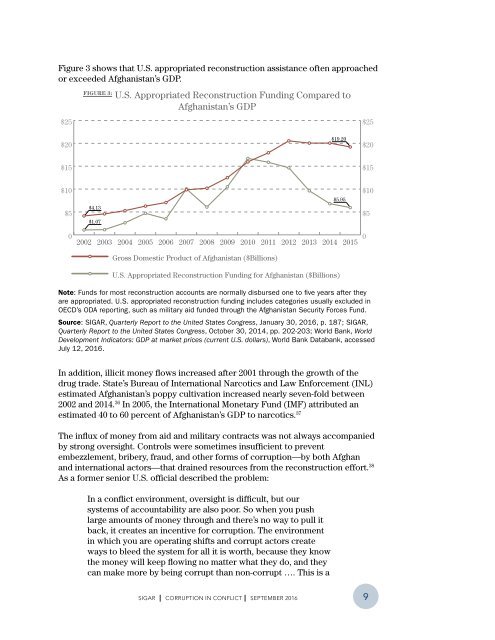CORRUPTION IN CONFLICT
5IlaWjQej
5IlaWjQej
You also want an ePaper? Increase the reach of your titles
YUMPU automatically turns print PDFs into web optimized ePapers that Google loves.
Figure 3 shows that U.S. appropriated reconstruction assistance often approached<br />
or exceeded Afghanistan’s GDP.<br />
FIGURE 3:<br />
U.S. Appropriated Reconstruction Funding Compared to<br />
Afghanistan’s GDP<br />
$25<br />
$25<br />
$20<br />
$19.20<br />
$20<br />
$15<br />
$15<br />
$10<br />
$5<br />
$4.13<br />
$1.07<br />
$5.95<br />
$10<br />
$5<br />
0<br />
2002<br />
2003<br />
2004<br />
2005<br />
2006<br />
2007<br />
2008<br />
2009<br />
2010<br />
2011<br />
2012<br />
2013<br />
2014<br />
2015<br />
0<br />
Gross Domestic Product of Afghanistan ($Billions)<br />
U.S. Appropriated Reconstruction Funding for Afghanistan ($Billions)<br />
Note: Funds for most reconstruction accounts are normally disbursed one to five years after they<br />
are appropriated. U.S. appropriated reconstruction funding includes categories usually excluded in<br />
OECD’s ODA reporting, such as military aid funded through the Afghanistan Security Forces Fund.<br />
Source: SIGAR, Quarterly Report to the United States Congress, January 30, 2016, p. 187; SIGAR,<br />
Quarterly Report to the United States Congress, October 30, 2014, pp. 202-203; World Bank, World<br />
Development Indicators: GDP at market prices (current U.S. dollars), World Bank Databank, accessed<br />
July 12, 2016.<br />
In addition, illicit money flows increased after 2001 through the growth of the<br />
drug trade. State’s Bureau of International Narcotics and Law Enforcement (<strong>IN</strong>L)<br />
estimated Afghanistan’s poppy cultivation increased nearly seven-fold between<br />
2002 and 2014. 36 In 2005, the International Monetary Fund (IMF) attributed an<br />
estimated 40 to 60 percent of Afghanistan’s GDP to narcotics. 37<br />
The influx of money from aid and military contracts was not always accompanied<br />
by strong oversight. Controls were sometimes insufficient to prevent<br />
embezzlement, bribery, fraud, and other forms of corruption—by both Afghan<br />
and international actors—that drained resources from the reconstruction effort. 38<br />
As a former senior U.S. official described the problem:<br />
In a conflict environment, oversight is difficult, but our<br />
systems of accountability are also poor. So when you push<br />
large amounts of money through and there’s no way to pull it<br />
back, it creates an incentive for corruption. The environment<br />
in which you are operating shifts and corrupt actors create<br />
ways to bleed the system for all it is worth, because they know<br />
the money will keep flowing no matter what they do, and they<br />
can make more by being corrupt than non-corrupt …. This is a<br />
SIGAR I <strong>CORRUPTION</strong> <strong>IN</strong> <strong>CONFLICT</strong> I SEPTEMBER 2016<br />
9


